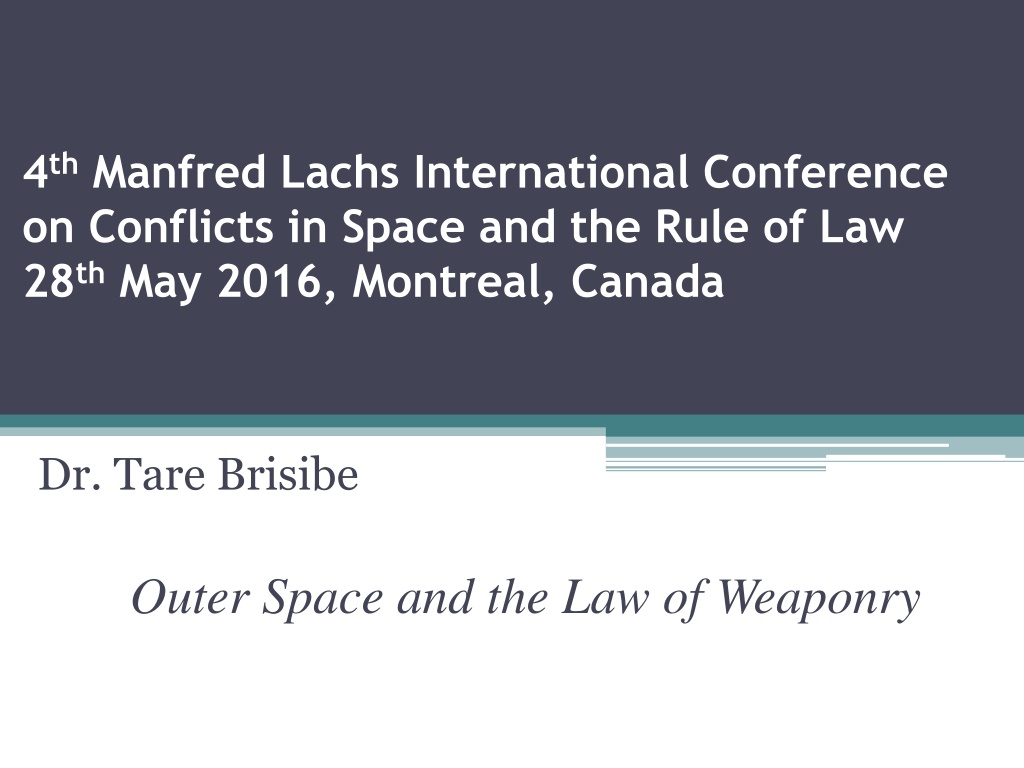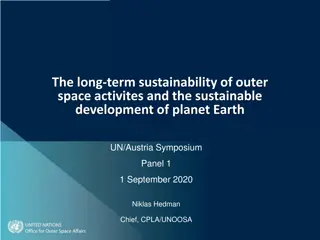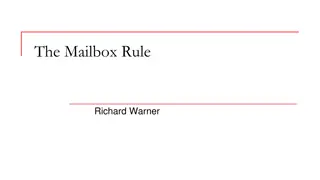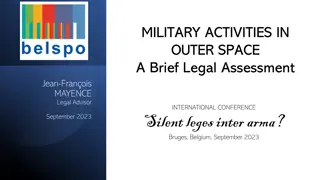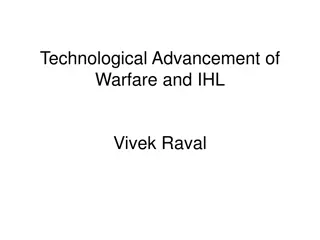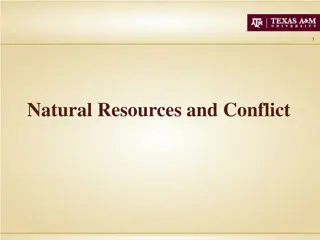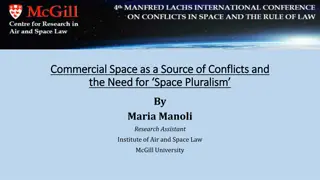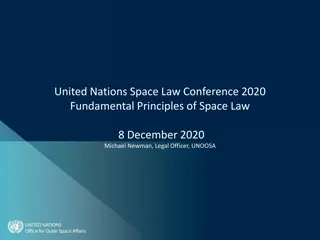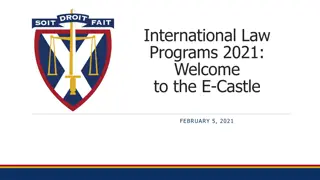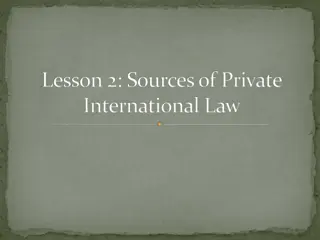The Manfred Lachs International Conference on Conflicts in Space and the Rule of Law
The 4th Manfred Lachs International Conference held in Montreal in 2016 explored the intersection of conflicts in space and the rule of law, specifically focusing on the legal framework surrounding outer space weaponry. Discussions highlighted the importance of upholding humanitarian values, promoting peaceful uses of outer space, and adhering to international space law principles. Various aspects, including the protection of humanitarian values, peaceful use, common interests, and particularities of outer space activities, were addressed during the conference. The conclusive remarks emphasized the humanitarian nature of established principles and rules of warfare applicable in armed conflicts, underscoring the need to comply with international laws and regulations in outer space exploration and usage.
Download Presentation

Please find below an Image/Link to download the presentation.
The content on the website is provided AS IS for your information and personal use only. It may not be sold, licensed, or shared on other websites without obtaining consent from the author. Download presentation by click this link. If you encounter any issues during the download, it is possible that the publisher has removed the file from their server.
E N D
Presentation Transcript
4thManfred Lachs International Conference on Conflicts in Space and the Rule of Law 28thMay 2016, Montreal, Canada Dr. Tare Brisibe Outer Space and the Law of Weaponry
Outline Objectives Humanitarian Values and Peaceful Use Particularities Concluding Remarks
Objectives International Space Law The common interest of humanity in furthering the peaceful use of outer space Law of Weaponry Protect humanitarian values
Protect Humanitarian Values Customary Principles of Weapons law The rights of the parties to an armed conflict to choose methods or means of warfare is not unlimited Art. 35 (1) Additional Protocol I, 1977 Geneva Conventions, 1949 Prohibited to employ weapons, projectiles and material and methods of warfare of a nature to cause superfluous injury or unnecessary suffering Art. 35 (2) Additional Protocol I, 1977 - Geneva Conventions, 1949 Prohibited to employ weapons, means or methods of warfare which are indiscriminate by nature Art. 51 (4) Additional Protocol I, 1977 Geneva Conventions, 1949 Treaty Provisions
Common Interest and Peaceful Use the common interest of mankind as a whole in furthering the peaceful use of outer space . [or] the progress of the exploration and use of outer space for peaceful purposes . General Assembly Resolutions: 1472 (XIV) 1959; 1962 (XVIII) 1963; 1721 (XVI) 1961; Outer Space Treaty 1967; Liability Convention 1972; Registration Convention 1976; Art. 3 Moon Agreement 1982 The moon and other celestial bodies shall be used by all States Parties to the Treaty exclusively for peaceful purposes. Art. IV Outer Space Treaty, 1967
Particularities General Application Outer Space Activities Human Rights Protecting the Environment Exceptions to and restrictions on the Use or threat of Force Disarmament intertwined with law of weaponry Politico-Military Considerations Doctrinal objectives for maintaining peace and security Obligations associated with weapons reviews Legality of weapons in the absence of prohibitions Non-State actors
Concluding Remarks States Parties to the Treaty shall carry on activities in the exploration and use of outer space, including the moon and other celestial bodies, in accordance with international law, including the Charter of the United Nations Art. III Outer Space Treaty, 1967 .the intrinsically humanitarian character [of the established principles and rules of humanitarian law applicable in armed conflict] permeates the entire law of armed conflict and applies to all forms of warfare and to all kinds of weapons, those of the past, those of the present and those of the future . International Court of Justice, Legality of the Threat or Use of Nuclear Weapons, Advisory Opinion, 1996 the usefulness of an analogy is of course conditioned by the experience acquired in operating a given rule or institution. But just as obviously, it is only when it really fits the new situation that it offers assistance sometimes in the application of an existing rule mutatis mutandis, more often in pointing the way to a new rule. It is in any case a serious mistake to employ analogy for the purpose of bringing a new developing branch of international law within the purview of traditional systems inseparable from institutions whose own transmutation is in progress. Analogy must be used creatively . Judge Manfred Lachs, 1972
